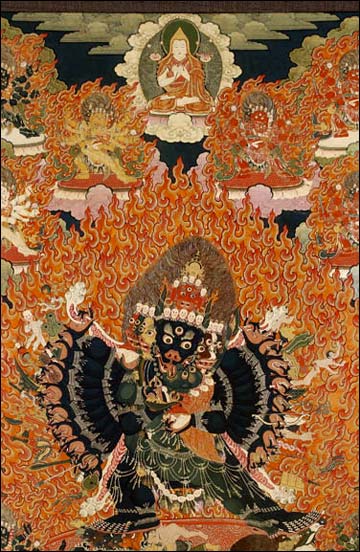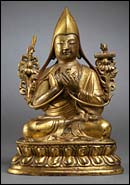
Mahâvajrabhairava. Distemper on cloth, Tibet, XVIIIe-XIXe siècles. Inv. Ver. 242. |
|
MUSÉES ROYAUX D'ART ET D'HISTOIRE
Parc du Cinquantenaire 10
1000 BRUXELLES
INFORMATION:
Tél. : 02 741 72 11
Fax. : 02 733 77 35
Email : info@mrah.be
Site : www.mrah.be
OPENING HOURS:
Tuesday to Sunday 10am to 5pm
Closed Monday and May 1st
Cash desks closed at 4:00 PM
PRICES OF ADMISSION:
Full rate: 5€
Concessions: 4€ -2€
PRESS CONTACTS:
Bart Suys
Tel.: 02 741 73 00
Email: b.suys@kmkg.be

|
Pushed by his passion for the Far East, Léon Verbert (1879 – 1941) headed there as soon as he finished his studies. In 1907 he was in China and, in 1908, he made an illustrated report on the Dalaï Lama’s visit to Beijing. Throughout his long stay and his numerous trips in the region, he collected some 600 pieces, and handed it 50 years ago to the Musées royaux d’Art et d’Histoire (Royal Museums of Art and History ).
An art rooted in Buddhism.
Tibetan art is essentially religious, rooted in Buddhism. The fact of making a painting that can be rolled up, or thang-ka - «that one rolls up» - is a religious act that not only increases the merits of the sponsor or the believer concerned, but also that of the painter. For example, to execute the eyes of the divine figures, the artist waits until the very last moment, when the work is completely coloured. Only then can the ceremonial act of «opening the eyes» take place, and only then can the Buddhas and bodhisattvas come into contact with human beings, through painting. The thang-ka is carried out under the watchful eye of a lama. The objects acquire a religious value and are ready to be used in rites only after a ceremony of consecration, during which names, praise or magic formulas are sometimes written on the back of the painting.
Unique pieces
The pieces from the Verbert collection date from the period between the XVIIth and the XIXth centuries, and originate basically from the provinces of Amdo and Kham, in Eastern Tibet. The exhibition presents for the first time all 200 thang-ka from the collection, of which the majority is shown for the first time to the public. 56 may be seen in the temporary exhibition, 24 hang in the permanent room dedicated to Tibet and Nepal, and 120 may be discovered in detail through an interactive programme that can be looked at on computer screens. In this last case, the image of each thang-ka is accompanied by a short text that includes an iconographic analysis. The Royal Art and History Museums will take this opportunity to show a complete series of twelve unique and entirely restored thang-ka, describing the main events in the life of Buddha. This ensemble is completed by bronze statues, ritual objects and some music instruments, such as we can see them represented on the thang-ka .
Illustration: Tsong-kha-pa (1357-1419). Gilded bronze, Tibet, 19th century. Inv. Ver. 44.
PUBLICATION
Exhibition catalogue Art of Tibet Texts by Miriam Lambrecht, curator of the Indian and South East asiatic collection Musées royaux d'Art et d'Histoire à Bruxelles Photos: Hugo Maertens 24 x 30 cm
With a cd-rom reproducing the 200 thang-ka
|









